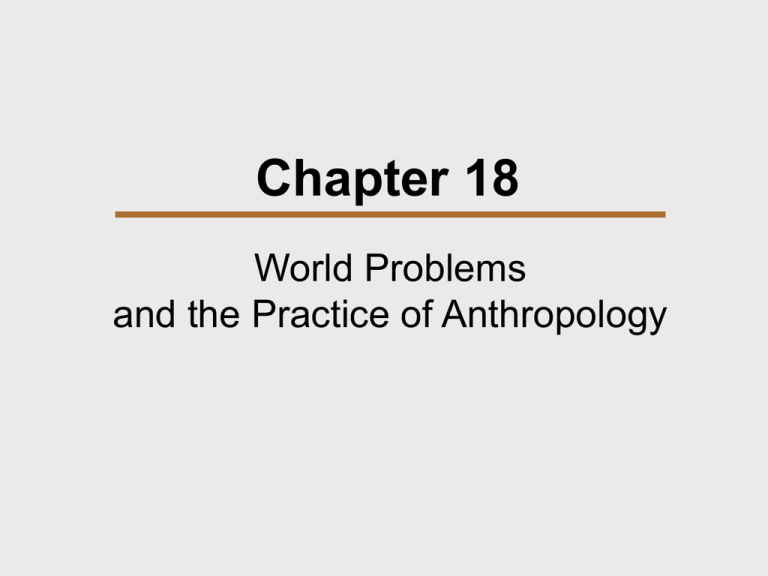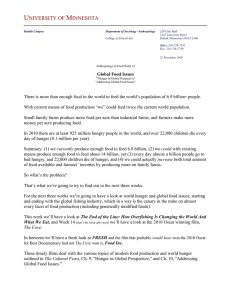Chapter 18, World Problems and the Practice of Anthropology
advertisement

Chapter 18 World Problems and the Practice of Anthropology Chapter Outline Applied Anthropology Population Growth World Hunger Anthropologists as Advocates Applied Anthropology: World view Attention to small-scale communities Insistence on prior detailed knowledge Sensitivity to cultural differences Appreciation of alternatives Recognition of systematic complexity Applied Anthropology The application of anthropological perspectives, theory, empirical knowledge of cultures and methods to help assess and solve human problems. LDC Lesser developed country. Population Growth In the last 50 years, world population has more than doubled. Most population growth occurs in the poorer countries of the world. Overpopulation in Latin America, Africa, and parts of Asia is resulting in ethnic and social conflict, environmental degradation and massive migration Factors Limiting Family Size in North America Cultural norms and social expectations about family size Occupational and spatial mobility Women’s employment Social burdens of children Factors Encouraging Larger Families in LDC’s High rates of infant mortality Extended families Low monetary cost of children Women's tasks are not incompatible with child care. Explanations for World Hunger Scarcity - hunger is caused by overpopulation Inequality -hunger is caused by unequal distribution of resources Scarcity Explanation of Hunger The major cause of hunger in the LDCs is overpopulation: Populations have grown so large that available land and technology cannot produce enough food to feed them. Inequality Explanation of Hunger The unequal distribution of resources is largely responsible for chronic hunger on a worldwide basis. Technology Transfer Solution Applying modern scientific know-how and technology to areas in which agriculture is still technologically underdeveloped. Agricultural Alternatives Intercropping Traditional resource management Indigenous Peoples Small scale human societies who make their living by foraging, farming, and /or herding, living in roughly the same region as their ancestors, and are fairly remote from the economic and political centers of the countries that include their territory. Medicinal Wisdom Peruvian Indians taught Europeans to use quinine to treat malaria treatment. Madagascar periwinkle used in folk medicine to treat diabetes. Medicinal Wisdom South American Indians used curare, a muscle relaxant as arrow poisoning and scientists learned of its value as a muscle relaxant. Ancient Greeks and north American Indian tribes used willow bark to treat pain and fever. This was synthesized into aspirin. Adaptive Wisdom of Preindustrial Peoples Selecting crops that grow and yield well in their habitat. Controlling insect pests and diseases that attack the plants on which they depend. Learning how to make nature work for them. Quick Quiz 1. Which of the following is not a part of the anthropological world view? a) b) c) d) attention to small-scale communities sensitivity to cultural differences ideological ethnocentrism recognition of systemic complexity Answer: c Ideological ethnocentrism is not a part of the anthropological worldview. 2. Couples in North America and LDCs are alike in that both: a) b) c) d) wish to limit the size of their families weigh the consequences their reproductive decisions will have on the broader society in which they live make reproductive decisions in terms of their own personal lives wish to limit the size of families, but North Americans use birth control to do this, whereas couples in LDCs are too poor to use such measures Answer: c Couples in North America and LDCs are generally alike in that both make reproductive decisions in terms of their own personal lives. 3. Which is an example of traditional resource management? a) b) c) d) intercropping of corn and squash in parts of Mexico the planting of an export crop such as coffee for extra cash in El Salvador the planting of fruit trees in fallowed fields in parts of Mexico using birth control among peoples of LDCs Answer: c The planting of fruit trees in fallowed fields in parts of Mexico is an example of traditional resource management.





